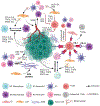Emerging Trends in Gastrointestinal Cancer Targeted Therapies: Harnessing Tumor Microenvironment, Immune Factors, and Metabolomics Insights
- PMID: 38759843
- PMCID: PMC11793124
- DOI: 10.1053/j.gastro.2024.05.005
Emerging Trends in Gastrointestinal Cancer Targeted Therapies: Harnessing Tumor Microenvironment, Immune Factors, and Metabolomics Insights
Abstract
Gastrointestinal (GI) cancers are the leading cause of new cancer cases and cancer-related deaths worldwide. The treatment strategies for patients with GI tumors have focused on oncogenic molecular profiles associated with tumor cells. Recent evidence has demonstrated that the tumor cell functions are modulated by its microenvironment, compromising fibroblasts, extracellular matrices, microbiome, immune cells, and the enteric nervous system. Along with the tumor microenvironment components, alterations in key metabolic pathways have emerged as a hallmark of tumor cells. From these perspectives, this review will highlight the functions of different cellular components of the GI tumor microenvironment and their implications for treatment. Furthermore, we discuss the major metabolic reprogramming in GI tumor cells and how understanding metabolic rewiring could lead to new therapeutic strategies. Finally, we briefly summarize the targeted agents currently being studied in GI cancers. Understanding the complex interplay between tumor cell-intrinsic and -extrinsic factors during tumor progression is critical for developing new therapeutic strategies.
Keywords: Gastrointestinal Cancers; Immune Landscapes; Metabolic Reprogramming; Targeted Therapies; Tumor Microenvironment.
Published by Elsevier Inc.
Conflict of interest statement
COMPETING INTERESTS
SKB is one of the co-founders of Sanguine Diagnostics and Therapeutics, Inc. The other authors declare no competing interests.
Figures




References
-
- Siegel RL, Miller KD, Fuchs HE, et al. Cancer statistics, 2022. CA Cancer J Clin 2022;72:7–33. - PubMed
Publication types
MeSH terms
Substances
Grants and funding
LinkOut - more resources
Full Text Sources

